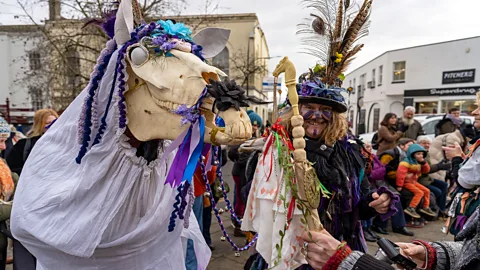Four of Europe’s most fascinating pre-Christian winter festivals
-
Ivan Brown
- Estimated read time 4 min read
- December 13, 2024
Christmas is the dominant holiday in the Western winter, recognized by its familiar figures—Jesus, the Holy Family, and gift-bringers like Father Christmas and the Three Magi. Yet, hidden within the celebrations, a cast of shadowy figures still lingers, drawing from Europe’s pre-Christian traditions. These mysterious characters, ranging from witches and demons to spirits of nature, offer a glimpse into the ancient folklore that once filled the winter season.
While the Church historically sought to eradicate these folkloric figures, many persisted, adapting into Christian customs and enriching the vibrant festivals we still celebrate today. Here are some of the most fascinating, lesser-known Christmas traditions that reflect Europe’s mythical past:
Festa della Befana, Italy

In Italy, the figure of La Befana, a witch who delivers gifts on the night of January 5 (Epiphany Eve), seems out of place in a deeply Catholic country. However, La Befana shares many similarities with Father Christmas. She flies through the night on a broomstick, enters homes via the chimney, and rewards well-behaved children with toys and candy, while leaving coal for those who misbehave.
While La Befana’s origins are debated, many scholars trace her back to ancient Roman goddess Strenua, who was associated with new year’s gift-giving. In Italian Christian folklore, she is said to have sheltered the Three Magi on their journey to find Jesus. Every January, the Festa della Befana in Urbania celebrates this witchy gift-bringer, where visitors can enjoy local sweets, browse pop-up markets, and watch costumed witches “fly” between church towers.
Krampusnacht, European Alps

December 6 marks the feast day of Saint Nicholas, a 3rd-century bishop who became the inspiration for Father Christmas. But the night before, December 5, is marked by the dark and eerie Krampusnacht. In the Alpine regions of Germany, Austria, and South Tyrol, towns come alive with Krampus, a terrifying figure—half-man, half-goat—with horns, dark fur, and a long tongue. Krampus is Saint Nicholas’ sinister counterpart, punishing naughty children by beating them with birch rods or carrying them off to hell in a basket.
Krampus is believed to have pre-Christian roots, and like La Befana, he was absorbed into Christian customs over time. The Krampuslauf (Krampus Run) is a central part of the festivities, where locals dress up in Krampus costumes, drink schnapps, and shake bells to drive away bad spirits. The largest Krampuslauf happens in Salzburg, Austria, drawing huge crowds each year.
Mari Lwyd, Wales

In Wales, an ancient folk tradition known as the Mari Lwyd brings a horse’s skull decorated with tinsel and baubles to life. This bizarre custom, typically performed during the Christmas and New Year period, sees the skull mounted on a pole and carried by a man under a bedsheet. With a group of followers, the Mari Lwyd goes door-to-door, engaging in a poetic battle for food and drink.
The Mari Lwyd is thought to have its roots in pagan or Celtic traditions, with echoes of wassailing, a custom where people visited homes singing and offering drinks in exchange for gifts. The most significant Mari Lwyd event takes place in Chepstow, Wales, each January, where participants go from house to house and perform Morris dances before gathering for an apple wassail—pouring cider over tree roots to ensure a good harvest.
Bear Dance, Romania

On December 30, the small towns and villages of Moldavia, Romania, witness a truly unique winter tradition—the Bear Dance. In a country known for its large population of brown bears, this ancient custom sees locals donning real bear skins, passed down through generations, and performing a dance through town. The bear figures, symbolizing strength and renewal, represent the coming of the new year.
The dance’s origins date back to the Geto-Dacians, ancient Indo-European tribes who revered the bear as a sacred symbol. The Bear Dance is performed with drums and pan flutes, and the dance itself depicts the death and resurrection of the bear—symbolizing renewal for the coming year. The town of Comănești hosts the largest and most famous Bear Dance festival, drawing crowds to witness this fascinating and powerful spectacle.
These ancient winter traditions provide a magical glimpse into Europe’s pagan past, illustrating how ancient customs have evolved and merged with Christian celebrations over the centuries. They remain an essential part of Europe’s cultural heritage and offer a fascinating contrast to the modern-day Christmas celebrations.